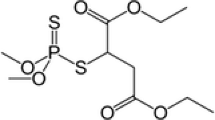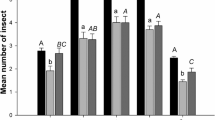Abstract
Lycoriella auripila (Winnertz) (Diptera: Sciaridae) is one of the most frequently seen pests of cultivated mushrooms, Agaricus bisporus (Lange) Imbach. The effects of different concentrations of diazinon, imidacloprid and deltamethrin, and tobacco extract were tested against L. auripila on varieties 737 and A15 of button mushroom. Also, economic injury level (EIL) of fungus gnat was evaluated on variety 737. Different varieties of button mushroom were cultured and weight of harvested mushrooms was recorded to provide an estimate of yield loss. A linear regression analysis was used to determine the relationship between pest density and mushroom yield. Imidacloprid was the most effective insecticide against L. auripila on both varieties and caused 100 % control at the highest tested concentration. The lowest concentration of diazinon (500 ppm a.i.) increased pest emergence on 737 and A15. This is possibly due to the hormoligosis. Deltamethrin and tobacco extract were ineffective against fungus gnat between both varieties. High levels of adults of L. auripila were associated with significant reduction in mushroom yield. EIL were calculated according to the number of L. auripila required to cause the critical yield loss from the predictive model and by control costs, mushroom price, and the reduction of injury due to spraying by imidacloprid and diazinon. The lowest values of EIL were related to imidacloprid compared with diazinon. This is due to the different efficiency of these two insecticides, for it causes mortality in population of L. auripila. Based on this research, for the first time clear EILs are introduced to the button mushroom growers for treatment of L. auripila.

Similar content being viewed by others
References
Al-mazra’awi MS, Ateyyat M (2009) Insecticidal and repellent activities of medicinal plant extracts against the sweet potato whitefly, Bemisia tabaci (Hom.: Aleyrodidae) and its parasitoid Eretmocerus mundus (Hym.: Aphelinidae). J Pest Sci 82:149–154
Alston DG (1996) Pest management decision-making: the economic injury level concept. Utah State University Press, Logan
Calabrese EJ, Baldwi LA (2003) Hormesis: the dose–response revolution. Annu Rev Pharmacol Toxicol 43:175–197
Calabrese EJ, Baldwin LA, Holland CD (1999) Hormesis: a highly generalizable and reproducible phenomenon with important implications for risk assessment. Risk Anal 19:261–281
Cameron PJ, Walker GP, Herman TJB, Wallace AR (2001) Development of economic thresholds and monitoring systems for Helicoverpa armigera (Lepidoptera: Noctuidae) in tomatoes. J Econ Entomol 94:1104–1112
Castle SJ, Prabhaker N (2011) Field evaluation of two systemic neonicotinoid insecticides against pink hibiscus mealybug (Maconellicoccus hirsutus (Green)) on mulberry trees. J Pest Sci 84:363–371
Dutcher JD (2007) A review of resurgence and replacement causing pest outbreaks in IPM. In: Ciancio A, Mukerji KG (eds) General concepts in integrated pest and disease management. Springer, Dordrecht, pp 27–43
Fletcher JT, Gaze RH (2008) Mushroom pest and disease control. Manson Publishing, London
Hassani MR, Nouri-Ganbalani G, Izadi H, Shojai M, Basirat M (2009) Economic injury level of the psyllid, Agonoscena pistaciae, on pistachio, Pistacia vera cv. Ohadi. J Insect Sci 9:40. www.insectscience.org/9.40. Accessed 12 June 2009
Higley LG, Pedigo LP (1996) Introduction to pest management and thresholds. In: Higley LG, Pedigo LP (eds) Economic threshold for integrated pest management. University of Nebraska Press, Lincoln, pp 3–9
Hussey NW, Gurney B (1968) Biology and control of the sciarid Lycoriella auripila (Winnertz) (Diptera: Lycoriidae) in mushroom culture. Ann Appl Biol 62:395–403
Kuenen DJ (1958) Influence of sublethal doses of DDT upon multiplication rate of Sitophilus granarius (Coleoptera: Curculionidae). Entomologia Exp et App 1:147–152
Larsson h (2005) Economic damage by Limothrips denticornis in rye, triticale and winter barley. J Appl Entomol 129:386–392
Lowery DT, Sears MK (1986a) Effect of exposure to the insecticide azinphomethyl on reproduction of green peach aphid (Homoptera: Aphididae). J Econ Entomol 79:1534–1538
Lowery DT, Sears MK (1986b) Stimulation of reproduction of the green peach aphid (Homoptera: Aphididae) by azinphosmethyl applied to potatoes. J Econ Entomol 9:1530–1533
Morse JG, Zareh N (1991) Pesticide-induced hormoligosis of citrus thrips (Thysanoptera: Thripidae) fecundity. J Econ Entomol 84:1169–1174
Musser FR, Catchot AL, Gibson BK, Knighten KS (2011) Economic injury levels for southern green stink bugs (Hemiptera: Pentatomidae) in R7 growth stage soybeans. Crop Prot 30:63–69
Nava-Camberos U, Riley DG, Harris MK (2001) Density-yield relationship and economic injury levels for Bemisia argentiifolii in cantaloupe in Texas. J Econ Entomol 94:180–189
Pavan F, Girolami V, Sacilotto G (1998) Second generation of grape berry moths, Lobesia botrana (Den. & Schiff.) (Lep., Tortricidae) and Eupoecilia ambiguella (Hb.) (Lep., Cochylidae): spatial and frequency distributions of larvae, weight loss and economic injury level. J Appl Entomol 122:361–368
Pedigo LP (2002) Entomology and pest management, 4th edn. Prentice-Hall, New Delhi
Ramírez OA, Saunders JL (1999) Estimating economic thresholds for pest control: an alternative procedure. J Econ Entomol 92:391–401
Richardson PN, Grewal PS (1991) Comparative assessment of biological (Nematoda: Steinernema feltiae) and chemical methods of control for the mushroom fly, Lycoriella auripila (Diptera: Sciaridae). Biocontrol Sci Technol 1:217–228
Riley DG (2003) Economic injury level (EIL) and economic threshold (ET) concepts in pest management. In: Capinera J (ed) Encyclopedia of entomology. Kluwer Academic Publishers, Norwell, pp 744–748
Rueda A, Badenes-Perez FR, Shelton AM (2007) Developing economic thresholds for onion thrips in Honduras. Crop Prot 26:1099–1107
Seagraves MP, Lundgren JG (2012) Effect of neonicotinoid seed treatments on soybean aphid and its natural enemies. J Pest Sci 85:125–132
Shad SA, Sayyed AH, Fazal S, Saleem MA, Zaka SM, Ali M (2012) Field evolved resistance to carbamates, organophosphates, pyrethroids, and new chemistry insecticides in Spodoptera litura Fab. (Lepidoptera: Noctuidae). J Pest Sci 85:153–162
Shamshad A, Clift AD, Mansfield S (2008) Toxicity of six commercially formulated insecticides and biopesticides to third instar larvae of mushroom sciarid, Lycoriella ingenua Dufour (Diptera: Sciaridae), in New South Wales, Australia. Aust J Entomol 47:256–260
Shipp JL, Wang K, Binns MR (2000) Economic injury levels for western flower thrips (Thysanoptera: Thripidae) on greenhouse cucumber. J Econ Entomol 93:1732–1740
SPSS (2007) SPSS base 16.0 user’s guide. SPSS Incorporation, Chicago
White PF (1986) The effects of sciarid Larvae (Lycoriella auripila) on cropping of the cultivated mushroom (Agaricus bisporus). Ann Appl Biol 109:11–17
White PF, Smith JE, Menzel F (2000) Distribution of sciaridae (Dipt.) species infesting commercial mushroom farms in Britain. Entomol Mon Mag 136:207–210
Wyatt IJ, Binns ES (1972) Insecticide granules in mushroom culture. Pest Sci 3:823–826
Žanić K, Goreta S, Perica S, Ŝutić J (2008) Effects of alternative pesticides on greenhouse whitefly in protected cultivation. J Pest Sci 81:161–166
Acknowledgments
We are grateful to the Department of Plant Protection, Razi University, for supporting this project.
Author information
Authors and Affiliations
Corresponding author
Additional information
"Communicated by K.J. Gorman".
Rights and permissions
About this article
Cite this article
Shirvani-Farsani, N., Zamani, A.A., Abbasi, S. et al. Toxicity of three insecticides and tobacco extract against the fungus gnat, Lycoriella auripila and the economic injury level of the gnat on button mushroom. J Pest Sci 86, 591–597 (2013). https://doi.org/10.1007/s10340-013-0486-x
Received:
Accepted:
Published:
Issue Date:
DOI: https://doi.org/10.1007/s10340-013-0486-x




